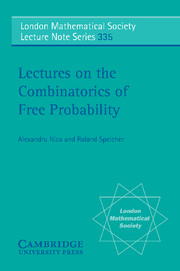Book contents
- Frontmatter
- Contents
- Introduction
- Part 1 Basic concepts
- Part 2 Cumulants
- Lecture 8 Motivation: free central limit theorem
- Lecture 9 Basic combinatorics I: non-crossing partitions
- Lecture 10 Basic combinatorics II: Möbius inversion
- Lecture 11 Free cumulants: definition and basic properties
- Lecture 12 Sums of free random variables
- Lecture 13 More about limit theorems and infinitely divisible distributions
- Lecture 14 Products of free random variables
- Lecture 15 R-diagonal elements
- Part 3 Transforms and models
- Notes and comments
- References
- Index
Lecture 9 - Basic combinatorics I: non-crossing partitions
Published online by Cambridge University Press: 06 July 2010
- Frontmatter
- Contents
- Introduction
- Part 1 Basic concepts
- Part 2 Cumulants
- Lecture 8 Motivation: free central limit theorem
- Lecture 9 Basic combinatorics I: non-crossing partitions
- Lecture 10 Basic combinatorics II: Möbius inversion
- Lecture 11 Free cumulants: definition and basic properties
- Lecture 12 Sums of free random variables
- Lecture 13 More about limit theorems and infinitely divisible distributions
- Lecture 14 Products of free random variables
- Lecture 15 R-diagonal elements
- Part 3 Transforms and models
- Notes and comments
- References
- Index
Summary
In the preceding lecture we saw that a special type of partitions seems to lie underneath the structure of free probability. These are the so-called “non-crossing” partitions. The study of the lattices of non-crossing partitions was started by combinatorialists quite some time before the development of free probability. In this and the next lecture we will introduce these objects in full generality and present their main combinatorial properties which are of relevance for us.
The preceding lecture has also told us that, from a combinatorial point of view, classical probability and free probability should behave as all partitions versus non-crossing partitions. Thus, we will also keep an eye on similarities and differences between these two cases.
Non-crossing partitions of an ordered set
Definitions 9.1. Let S be a finite totally ordered set.
(1) We call π = {V1, …, Vr} a partition of the set S if and only if the Vi (1 ≤ i ≤ r) are pairwise disjoint, non-void subsets of S such that V1 ∪ … ∪ Vr = S. We call V1, …, Vr the blocks of π. The number of blocks of π is denoted by |π|. Given two elements p, q ∈ S, we write p ∼πq if p and q belong to the same block of π.
(2) The set of all partitions of S is denoted by P(S). In the special case S = {1, …, n}, we denote this by P (n).
[…]
- Type
- Chapter
- Information
- Lectures on the Combinatorics of Free Probability , pp. 135 - 154Publisher: Cambridge University PressPrint publication year: 2006



